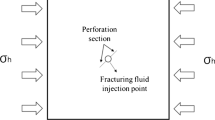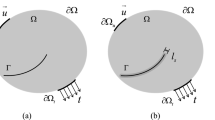Acid fracturing is a key measure to increase production of fracture-cavity reservoirs. Affected by the fracture-cavity system, hydraulic fractures will not propagate in a plane, and the mechanism of hydraulic fracture propagation is complicated. Therefore, considering the characteristics of hydraulic fracture propagation in fracture-cavity reservoirs, we established an extended finite element (XTEM) model for hydraulic fractures in fracture-cavity reservoirs. The simulation discussed hydraulic fracture extension in cases of a single cave and a single natural fracture and revealed the mechanism of dynamic propagation and extension of hydraulic fractures. The results indicated severe stress concentrations near caves, resulting in deflections of the fracture propagation direction. In the case of a single cave, upon shifts of shafts from the central line of the cave, the conditions of penetration of the cave by hydraulic fractures were investigated. It was shown that in the case of small approaching angles, the hydraulic fractures tend to deflect and join natural fractures; also, the hydraulic fractures can deflect and join natural fractures with large approaching angles and weak cementation. Generally small approaching angles and long natural fractures tend to induce hydraulic fractures and assist propagation towards the caves, thus increasing the probability of cave penetration.







Similar content being viewed by others
References
E. Gischler, R. Heindel, D. Birgel D, et aL, “Cryptic biostalactites in a submerged karst cave of the Belize Barrier Reef revisited: pendant bioconstractions cemented by microbial micrite,” Palaeogeog.. Palaeoclimatol., Palaeoecol., 468, 34-51(2017).
Zhifeng Luo, Nanlin Zhang, Liqiang Zhao, Li Ran, and Yang Zhang, “Numerical evaluation of shear and tensile stimulation volumes based on natural fracture failure mechanism in tight and shale reservoirs,” Environ. Earth Sci., 78(175), 1-15 (2019).
C. Li, X. Zhou, S. You, et al., “Analysis of two-phase gas-water flow in carbonate reservoirs,” J. Mini. Sci., 53(4), 643-654 (2018).
N. Lamont and F.W. Jessen, “The effects of existing fractures in rocks on the extension of hydraulic fractures,” J. Pet. Technol., 15(02), 203-209 (1963).
J. Zhou, M. Chen, Y. Jin, et. al., “Experimental study on propagation mechanism of hydraulic fracture in naturally fractured reservoir,” Acta Petrol. Sin., 28(5), 109-112 (2007).
T.R. Guo, S.C. Zhang, Z.Q. Qu, et al., “Experimental study of hydraulic fracturing for shale by stimulated reservoir volume,” Fuel, 128, 373-380 (2014).
Y. Chitrala, C. Moreno, C. Sondergeld, et. al., “An experimental investigation into hydraulic fracture propagation under different applied stresses in tight sands using acoustic emissions,” J. Pet. Sci. Eng., 108, 151-161(2013).
V.V. Zubkov, V.F. Roshelev, and A.M. Linkov, “Numerical modeling of hydraulic fracture initiation and development,” J. Mini .Sci., 43(1), 40-56 (2007).
N. Zangeneh, E. Eberhardt, and R.M. Bustin, “Application of the distinct-element method to investigate the influence of natural fractures and in situ stresses on hydro-fracture propagation,” 46th US Rock Mechanics/Geomechanics Symposium, American Rock Mechanics Association, 1-8 (2012).
Y. E. Aimene and J.A. Nairn, “Modeling multiple hydraulic fractures interacting with natural fractures using the material point method,” Society of Petroleum Engineers, 2014.
S.H. Advani, T.S. Lee, and J.K. Lee, “Three-dimensional modeling of hydraulic fractures in layered media: Part I - Finite Element Formulations,” J. Energy Res. Technol., 112(1), 1-9 (1990).
A.D. Taleghani and J.E. Olson, “How natural fractures could affect hydraulic-fracture geometry,” SPE J., 19 (1), 161-171 (2014).
L. Fei, L. Zhifeng, S. Yu, et al., “Deformation behavior between hydraulic and natural fractures using fully coupled hydromechanical model with XFEM,” Math. Probl. Eng., 2017, 1-12 (2017).
S. Salimzadeh, A. Paluszny, H.M. Nick, et al., “A three-dimensional coupled thermo-hydro-mechanical model for deformable fractured geothermal systems,” Geothermics, 71, 212-224 (2018).
B. Fan, J. Deng, H. Lin, et al., “Numerical simulation of hydraulic fracturing in weakly consolidated sandstone,” Chem. Technol. Fuels Oils, 53(1), 1-10 (2018).
B. Fan, J. Deng, L. Hai, et al., “Numerical simulation of hydraulic fracturing in weakly consolidated sandstone,” Chem. Technol. Fuels Oils, 53(6), 943-954 (2018).
Y. Fan, Y. Zhao, Z. Zhu, et al., “Stress intensity factors for a tunnel containing a radial crack under compression,” Adv. Mech. Eng., 9(12), 1-10 (2017).
Z. Luo, N. Zhang, L. Zhao, L. Yao and F. Liu, “Seepage-stress coupling mechanism for intersections between hydraulic fractures and natural fractures,” J. Pet. Sci. Eng., 171, 37-46 (2018).
E. Budyn, G Zi, S.N. Mo, et al., “A method for multiple crack growth in brittle materials without remeshing,” Int. J. Numer. Methods Eng., 61(10), 1741-1770 (2004).
T.P. Fries. “A corrected XFEM approximation without problems in blending elements,” Int. J. Numer. Methods Eng., 75(5), 503-532 (2008).
Y. Doug and Q. Ren, “ An extended finite element method for modeling hydraulic fracturing in gravity dam, J. Hydraul. Eng., 42(11), 1361-1367 (2011).
M. Sheng and G. Li, “Extended finite element modeling of hydraulic fracture propagation,” Eng. Mech., 31(10), 123-128 (2014).
A.D. Taleghani and J.E. Olson, “Analysis of multistranded hydraulic fracture propagation: an improved model for the interaction between induced and natural fractures,” SPE Technical Conference & Exhibition. Society of Petroleum Engineers, 2009.
Declaration of Conflicting Interests
The authors declare that there are no conicts of interest regarding the publication of this paper.
Funding
This work was supported by the National Science and Technology Major Projects (12016ZX05014). This support is gratefully acknowledged.
Author information
Authors and Affiliations
Corresponding author
Additional information
Translated from Khimiya i Tekhnologiya Topliv i Masel, No. 6, pp. 104 - Ill, November - December, 2019.
Rights and permissions
About this article
Cite this article
Zhao, H., Xie, Y., Zhao, L. et al. Simulation of Mechanism of Hydraulic Fracture Propagation in Fracture-Cavity Reservoirs. Chem Technol Fuels Oils 55, 814–827 (2020). https://doi.org/10.1007/s10553-020-01096-9
Published:
Issue Date:
DOI: https://doi.org/10.1007/s10553-020-01096-9




